Landscape Partnership Newsletter-WLFW Prescribed Burning Added To FY24 Climate-Smart Practice List
Based in part on the recent Fact Sheet on Opportunities for Research on Carbon Sequestration in Longleaf Pine Ecosystems by Kevin Robertson, Ph.D., Fire Ecology Research Scientist, Prescribed Burning has been added to the USDA Climate-Smart practice list for FY24.
** Read the Fact Sheet Influencing This Decision
** At A Glance: Reasons why NRCS decided to expand the list of practices eligible for USDA's Climate-Smart practice list to include prescribed burning.
------------------------------------------------------------
* Planting trees and suppressing wildfires do not necessarily maximize the carbon storage of natural ecosystems. New research has found that prescribed burning can lock in or increase carbon in the soils of temperate forests, savannas, and grasslands.
* Given that 70% of global topsoil Carbon is in fire-prone regions, using fire to promote soil organic matter stability may be an important nature-based climate solution to increase Carbon storage.
* Prescribed burns are widely recognized as a cost-effective tool for combating wildfires and increasing climate resilience by protecting organic materials accumulated as soil carbons from catastrophic wildfires that release large amounts of carbon.
* When fires are too frequent or intense -- as is often the case in densely planted forests -- they burn the dead plant material that would otherwise decompose and release carbon into the soil
* High-intensity fires can also destabilize the soil, breaking off carbon-based organic matter from minerals and killing soil bacteria and fungi. However infrequent, cooler fires can increase the retention of soil carbon through the formation of charcoal and soil aggregates that protect from decomposition.
* Assessment of wildland fires on working lands can be accomplished using existing geospatial data and models of burned area, burn severity, fuel consumption, fire emissions, and post-fire tree mortality.
* Much of the carbon in grasslands is stored below ground, in the roots of the plants. Controlled burning, which helps encourage grass growth, can increase root biomass and therefore increase the amount of carbon stored.
For more on USDA Climate Smart Priorities Visit The NRCS Website
Through Working Lands for Wildlife (WLFW), USDA uses a win-win approach to systematically target conservation efforts to improve agricultural and forest productivity which enhance wildlife habitat on working landscapes. Wildlife and agriculture can thrive in harmony—that's the heart of the vision that WLFW shares with landowners and partners. In the East and Central US the Working Lands For Wildlife Information sharing portal enables interaction between NRCS's WLFW partners and others interested in conserving whole landscapes and empowering rural economies.
The Landscape Partnership portal is an interactive platform where landowners and professionals from any agency, organization or industry can share technical information, host GIS mapping products and a variety of decision-support tools, view and download online learning materials, find out about partnership activities and newly funded projects, and identify technical experts who are available to provide assistance. The Working Lands for Wildlife website is built on this platform and shares information.
The Working Lands for Wildlife portal allows users (including landowners) access to an interactive network including:
* A wide variety of information
* Online training materials
* Planning and decision-support tools
* Online workspaces
* Human resources: partners, NRCS field staff, and landowners
* Expertise Database
* Landscape Frameworks and Wildlife



























